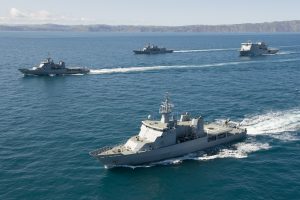Last week New Zealand Defence Minister Ron Mark met with his Canadian counterpart, Harjit Sajjin, in Ottawa. However, on his way to the Canadian capital Mark made a stopover in Victoria, British Columbia, on Canada’s Pacific coast. At the Victoria Shipyard two of the Royal New Zealand Navy (RNZN) Anzac-class frigates — the HMNZS Te Mana and the HMNZS Te Kahn — are undergoing combat system upgrades and Mark was there to inspect their progress. This is notable as the two RNZN vessels are the first foreign warships to be modernized in Canada since World War II, making the contract not just an important bilateral development between the two countries, but also an important component of Canada’s involvement in Indo-Pacific security.
In September last year I wrote an article for the Lowy Interpreter that illustrated the forces that are beginning to shift Canada from an Atlantic-facing country to a Pacific-facing one. This will remain a long-term process, as the majority of the country’s population — and their cultural affinities — are still weighted toward its Atlantic coast, and of course its prominent southern neighbor. However, Ottawa’s cooperation with New Zealand in the upgrading of the RNZN frigates is a prominent symbol of Ottawa’s intent to enhance its security capabilities on its Pacific coast, a recognition of the global shift in power toward the Indo-Pacific, and of Canada’s need to involve itself in that shift.
While Canada is yet to adopt the shift in lexicon from Asia-Pacific to Indo-Pacific that its other major partners have adopted enthusiastically, Ottawa does seems to be adopting the sentiment. This change in terminology has not just been cosmetic, it reflects a change in priorities from one based on economic integration and growing prosperity, to a sterner security focus, a recognition that integration and prosperity may be increasingly under threat and greater protection of the norms that allowed for this growing prosperity is required.
For New Zealand, this new conception of the region also requires a reassessment of priorities.
In his speech at last year’s Shangri-La Dialogue in Singapore, Mark identified Wellington’s primary strategic zone as being one that extends from the South Pole and the Southern Ocean, and up through the Pacific to the Equator, and indicated that it was a priority for the New Zealand Defense Forces to be able to operate in the South Pacific at the same capacity as they can in New Zealand territory, the Southern Ocean, and Antarctica. In particular, Wellington’s focus is on being able to quickly respond to natural disasters within the South Pacific.
While the region may seem on the fringes of the Indo-Pacific, the South Pacific has become increasingly contested in recent years, with Wellington having to readjust itself to the reality of a non-aligned power, China, having an increasing footprint in the region. New Zealand’s shared regional identity as a Polynesian country and its foreign policy which focuses heavily on the South Pacific buys it much goodwill throughout the region, yet as a small country of limited capabilities its security concerns require a more collaborative approach.
In Australia, New Zealand has a longstanding and closely aligned partner, and the two countries work closely on aid, development, and security issues in the region. Yet being able to draw other trusted countries into the Pacific is a key element of New Zealand’s security strategy, and Canada looks to be a prime target. In 2017 Canada doubled its development funding for Pacific Island countries, and with its feminist foreign policy directing its focus toward improving health, education, safety and economic opportunities for women and girls in recognition of how many personal insecurities can lead to larger security dilemmas.
For a state such as New Zealand that lacks significant hard power, there is a reliance on its reputation in order to project influence. Trust becomes its most important asset, and with this trust comes an ability to be creative, to seek out norms that it wishes to shift to its advantage and find partners willing to see the mutual benefit in this shift.
Awarding Canada a contract to upgrade the combat systems on two of its frigates (that were initially built in Australia) may seem like a small initiative, but it has the potential to enhance the ability for Canada to increase its capabilities in defense hardware and as a more active security provider. And for Wellington’s purposes, assist in Ottawa’s pivot toward its Pacific coast, and Indo-Pacific engagement.

































